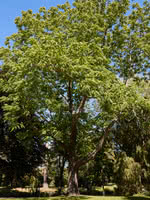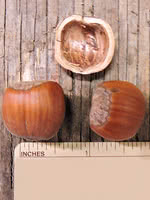Mon-Fri 9am - 5pm Mountain time
Black Walnut vs Andrew Hazelnut
Juglans nigra
Corylus heterophylla Het 1
NOT AVAILABLE THIS SEASON - MIGHT RETURN
NOT AVAILABLE THIS SEASON - MIGHT RETURN
The Black Walnut is a slow growing, large, straight-stemmed tree with an open crown. It produces dense, very hard, edible nuts.
Black Walnut has a deeply-furrowed, black bark. Its leaves are about 1 foot long, composed of 15 - 23 slightly stalked leaflets on a moderately stout stock which provide good dappled shade.
Despite being highly valued for its edible nuts and its shade tree aesthetics, it is rare to see this tree on the prairies.
Note: Black Walnut's roots produce a substance named juglone that is toxic to some other plants. Consider this when choosing where you plant a black walnut, as you will not be able to grow tomato, potato, cabbage, eggplant, blueberry, azalea, rhododendron, lilac, red pine and apple in the surrounding area.
Note: Plant this tree once. It will not respond well to transplanting.
Note: Although self-pollinating, planting two trees significantly improves nut production.
A top CO2 absorbing species. Experts think this tree may help climate change more than others.
Andrew Hazelnut is a northern cultivar that is grown specifically for its cold hardiness. Typically, hazelnuts produce smaller nuts in colder climates, but for Andrew Hazelnut, this is not the case.
This hybrid variety is incredibly productive, growing medium sized nuts that ripen in late August. Pair with another Andrew or Aldara Hazelnut for cross pollination to occur.
The edible nuts can be eaten fresh, used in baking, and will make a beautiful hedge. Andrew Hazelnut is also eastern filbert blight resistant.
Note: You want more than one hazelnut to improve yields.

